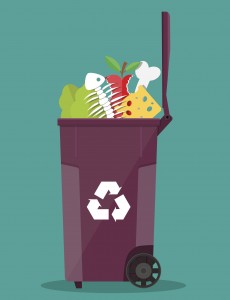How To Waste Less Food and Save Money

Imagine walking out of the grocery store with four bags full of fresh food, dropping one entire bag, and not bothering to pick it up.
Seems crazy, but that’s essentially what most of us are doing all the time. The average American throws away $30 each month in the form of uneaten food. Yup, the lettuce that went bad, the leftovers you never got around to eating, and the science experiment in the back of the fridge you’re hoping your husband will clean up one day—they all add up to 15 to 25 percent of the food you buy going uneaten.
U.S. consumers are collectively responsible for more wasted food than farmers, grocery stores or any other part of the food-supply chain—a problem that costs the average family about $1,500 every year.
 Meet the Waste Free Kitchen Handbook: A Guide To Eating Well and Saving Money by Wasting Less Food! This handbook by author Dana Gunders aims to put an end to wasting food, and making a difference has never been easier or more delicious!
Meet the Waste Free Kitchen Handbook: A Guide To Eating Well and Saving Money by Wasting Less Food! This handbook by author Dana Gunders aims to put an end to wasting food, and making a difference has never been easier or more delicious!
Packed with checklists, practical strategies, and simple recipes, the Handbook is the ultimate tool for reducing food waste at home. It includes easy tips on how to:
-Grocery shop smarter
-Plan meals better
-Decode expiration dates
-Use your fridge to its full potential
-Cook with leftover ingredients (including 20 tasty “use-it-up” recipes)
-Store foods properly, including specific shelf-life, storage and creative use-it-up ideas for more than 85 common foods
These guides can not only put more money back in consumers’ bank accounts, but reduce the strain on our environment. When food is wasted, so are all the resources that went into producing it:
-25 percent of our nation’s fresh water goes into producing food that is never eaten.
-If global food waste was a country, it would have the world’s largest greenhouse gas footprint after the U.S. and China—food waste just in the U.S. is responsible for emissions equal to those from 33 million cars.
-Food waste is the single largest component of solid waste in U.S. landfills.
-28 percent of the world’s agricultural land—an area larger than Canada—is used to grow food that gets wasted.
 “Food waste is a global problem we can tackle in our own homes,” Gunders said. “When we throw out perfectly good food, we throw out all of the resources used to get it to our table—massive amounts of land, energy and water—along with it. Small, easy changes in our daily routine can add up to big benefits for the environment, and big savings in our pockets.”
“Food waste is a global problem we can tackle in our own homes,” Gunders said. “When we throw out perfectly good food, we throw out all of the resources used to get it to our table—massive amounts of land, energy and water—along with it. Small, easy changes in our daily routine can add up to big benefits for the environment, and big savings in our pockets.”
Wasting less is not rocket science. It doesn’t require any gadgets either. While the collective impact of wasting less food is big, the action is about small, easy changes you can make in your daily food rhythm that will streamline your consumption.
Making those changes is the journey. It won’t be perfect. Milk will go sour, and dressing-drenched salad will get left on plates. Don’t be too hard on yourself! And enjoy trying new tricks and recipes along the way. Make it a game to see just how little you can throw in the trash. The more you enjoy the steps suggested in this book, the more likely you are to incorporate them into your regular kitchen act.
